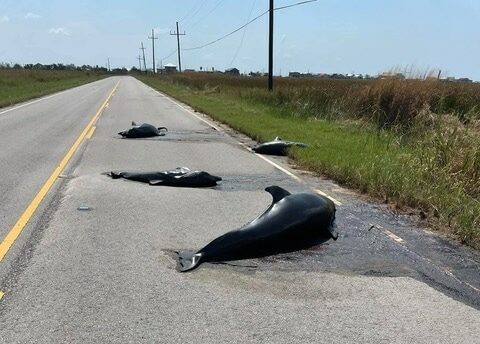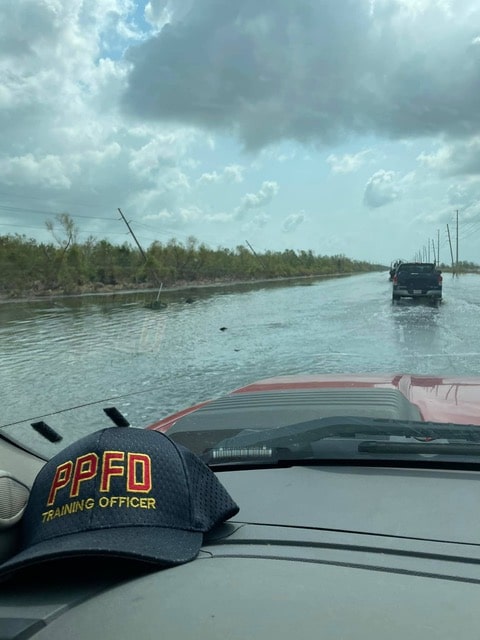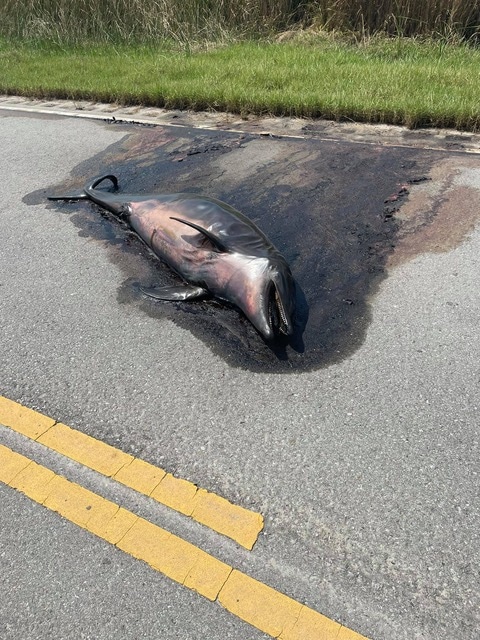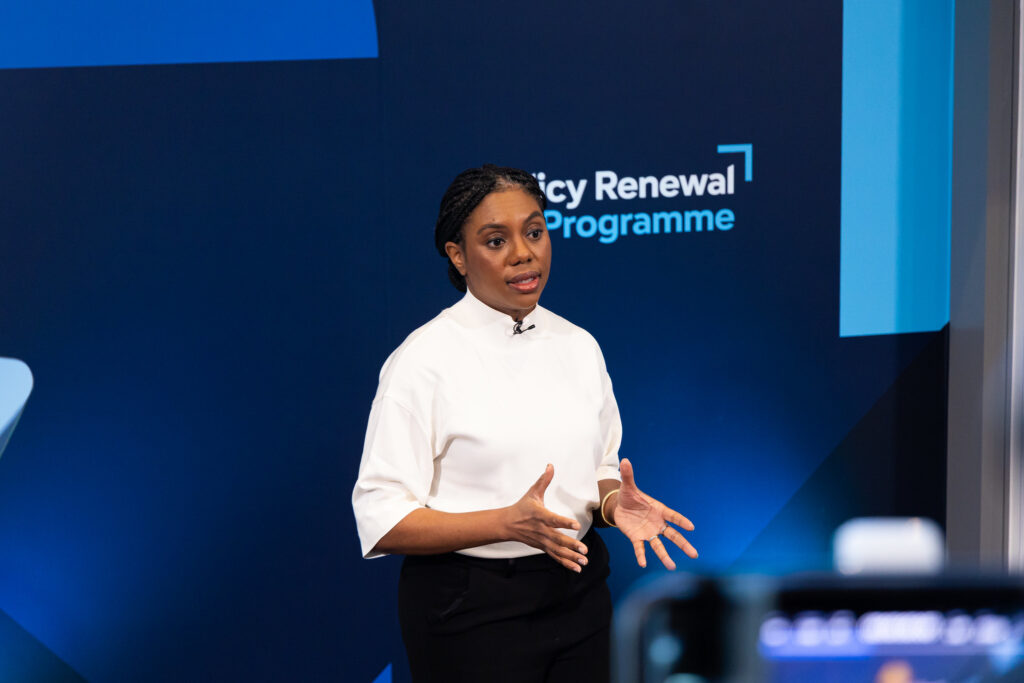By Rocky Kistner
Days after Hurricane Ida roared through coastal Louisiana, sending a 12-foot storm surge rushing across the marshlands south of New Orleans, Plaquemines Parish Fire Department Capt. Kevin Coleman was driving on a coastal road trying to reach his isolated fire station near Myrtle Grove, Louisiana.
As he drove toward Barataria Bay, he saw in the distance what looked like black plastic garbage bags littering the road. But as he drove closer his curiosity turned to horror. “What the hell,” he said to himself as he slammed on the brakes. Scattered along the road were the remains of four dead bottlenose dolphins, lying on the drying asphalt with mouths agape, a decaying pile of flesh that revealed their agonizing deaths.
Coleman jumped out of his vehicle and took a few pictures to capture the morbid moment he had just witnessed. The fire department captain didn’t have much time to reflect on what he had seen, but later he couldn’t shake the thought of what might be in store for the region’s dolphins. He says he worries that the future is not a bright one for the dolphins, as well as the oysters, shrimp, and salt-water fish that make the bay one of the most productive in the nation.
That’s because, he says, about six miles from where he found the dolphins dead in the middle of the road, the state of Louisiana plans to build an unprecedented multi-billion river diversion project. The goal is to build up marshland in Barataria Bay in order to mitigate coastal erosion. The plan is currently under federal environmental review.
Credit: Capt. Kevin Coleman, Plaquemines Parish Fire Department Credit: Capt. Kevin Coleman, Plaquemines Parish Fire Department
The project’s supporters, including major environmental nonprofits like the Environmental Defense Fund, the National Wildlife Federation, and the Audubon Society, say large river diversions are the most effective way to send land-building sediment streaming into the bayou from the Mississippi River to fight land subsidence and sea-level rise. Losing land at an alarming rate, Louisiana is one of the states most threatened by the impacts of climate change in the U.S.
The diversion project is part of a 50-year coastal restoration plan by the state, boosted by major funding from the Walton Family Foundation, which has supported a multi-million dollar PR and media campaign to promote the plan. The foundation also has funded local media coastal reporting efforts, which, along with national media stories, has largely been positive about the state’s diversion plan.
But that’s not how some locals and other marine mammal experts see it. The massive river diversions planned for Plaquemines and St. Bernard Parishes has run into a buzzsaw of opposition, as local fishing communities worry that the diversions will pour polluted Mississippi River water into the bay. The fear is that upstream chemicals, pesticides, and other toxins will change the salinity levels of the water and destroy one of the most productive fisheries in the country.
A study earlier this year found that the Barataria Bay diversion project could result in local dolphin populations becoming “functionally extinct.”
But in 2018 a Congressional lobbying effort successfully managed to insert an exemption to remove protections under the Marine Mammal Protection Act in order to allow the project to move forward.
Dolphin expert Moby Solangi, president and executive director of the Institute of Marine Mammal Studies in Gulfport, Mississippi, says finding four stranded dolphins on a road is unusual, but it’s not surprising given that climate change is contributing to bigger and more destructive storms. “The climate predictions of increased hurricanes and tropical storms in the region, and the proposed diversion of polluted Mississippi River in the Louisiana estuaries, will have a devastating effect on dolphins, turtles, fish and shellfish,” Solangi said.
Solangi and other marine mammal experts say dolphins are territorial and will not move, even if their habitat is threatened, and they will suffer deadly skin lesions disease caused by the planned massive inflows of river water.
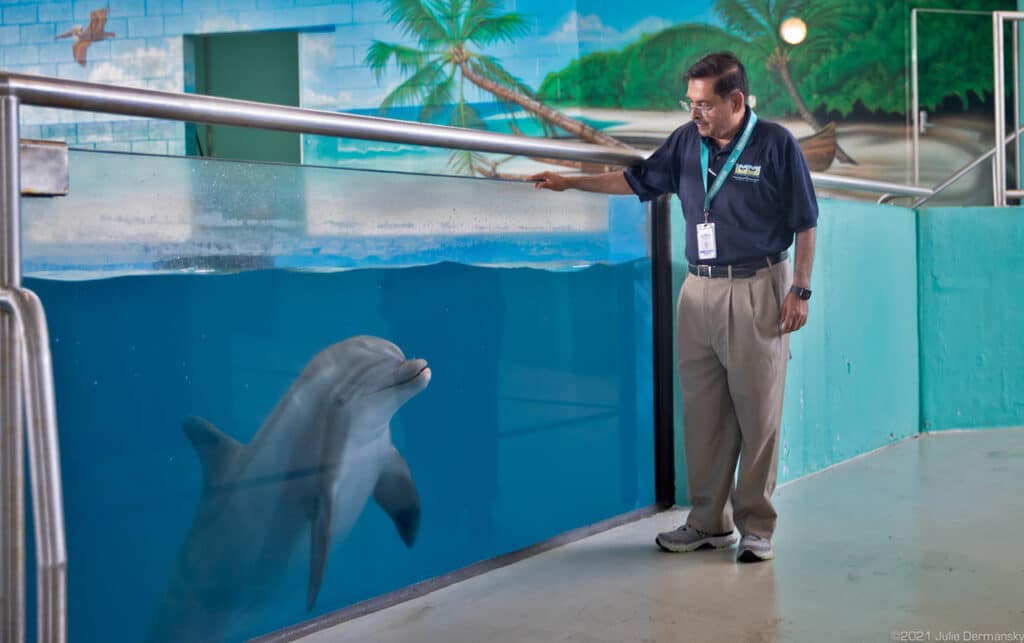
Dolphin populations are already stressed in the area, having been severely damaged by the historic BP oil disaster in 2010, which still impacts the dolphin populations in Barataria Bay today. Officials with the National Oceanic and Atmospheric Administration report that deadly dolphin strandings in Texas, western Louisiana, and coastal Florida are on the rise this year as well. Still, they haven’t approached the dangerous 2019 levels when record flooding pumped river runoff into the Gulf and contributed to the death of more than 300 hundred dolphins. Scientists say impacts of red tide and the toxic impacts of yearly “dead zones” caused by inflows of toxins and oxygen-killing algal blooms may be contributing too.
Meanwhile, Louisiana faces challenges to find all the dolphins that may be dying in its marshes, a major task considering the state essentially abandoned its stranding effort, a program to identify and recover marine mammals in distress, in the years following the 2010 BP disaster. Experts say many dolphins likely have died unidentified.
Gabriella Harlamert, coordinator of the Audubon Nature Institute’s wildlife stranding network, says the organization is trying to build up its resources, and that it now has its first boat on order. She says they were able to help rescue seven dolphins last year after Hurricane Laura slammed into the Louisiana coast, and they participated in a recent multi-agency rescue of a young dolphin trapped in Ida’s floodwaters in Slidell, Louisiana.
But Harlamert was too late to help save the four dolphins recently found in Plaquemines. Her small team responded to the stranding report, but she says the animals were too decomposed to do a proper necropsy. “I’ve never gotten dolphins like this that were so fragmented,” she says. She blames storm surge for trapping the animals, who likely got caught in a containment area by the road as the surging water rushed back into the bay.
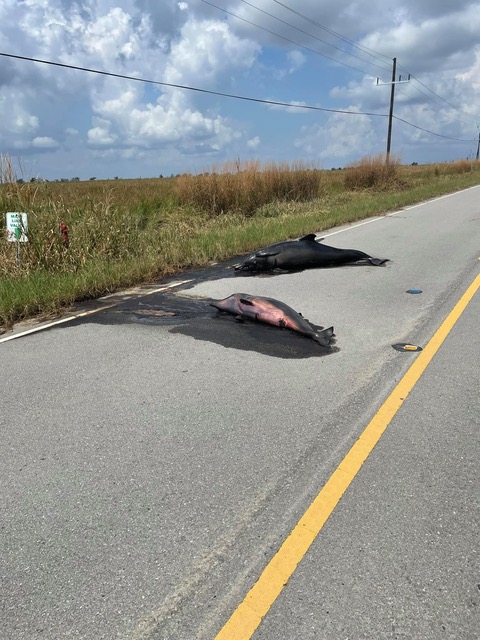
Public officials, however, like Lt. Governor Billy Nungesser, former president of Plaquemines Parish during the BP oil disaster, say the dolphins killed during Hurricane Ida are symbolic of a state’s coastal restoration plan gone awry.
Nungesser, who is in charge of Louisiana’s seafood promotion board, has made opposing the massive river diversion projects central to his likely run for governor in 2023. He said earlier this year that the future of Louisiana lies in protecting its fisheries, not the oil and gas industry, which he famously said “was going down.” He argues that the state should be focusing on more immediate, short-term projects they know work, such as more dredging and berms to help land areas which act as a buffer between storm surges and the coastline, instead of working on 50-year programs when it’s challenging to predict that far into the future.
“The dolphins on that road is a wake-up call,” Nungesser told Desmog. “How do they think they can dump all this polluted river water in there and not kill everything?”
Political leaders and residents in coastal areas that will be impacted by these diversions largely agree with the Lt. Governor. They say there are other ways to try to build coastal land that won’t destroy the fisheries in the process.
Dredging, for instance, also works to build land — but requires constant maintenance. The state says diversions can build land naturally. The question for many is: at what cost? Is it worth impacting dolphin populations and jeopardizing the fisheries? The state says it will compensate local communities for their losses, but locals say that is impossible. They say it will kill their livelihoods.
“There are more than two thousand dolphins in this area,” says Coleman. “The diversions will kill them … we need to stick with dredging.”
Subscribe to our newsletter
Stay up to date with DeSmog news and alerts


